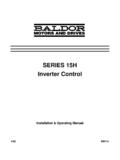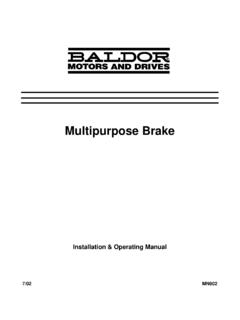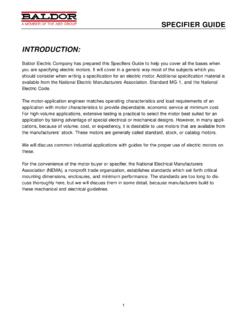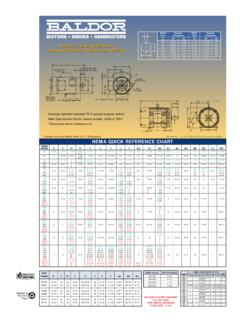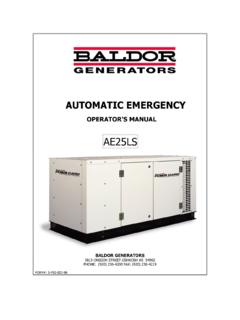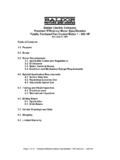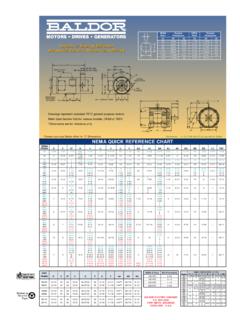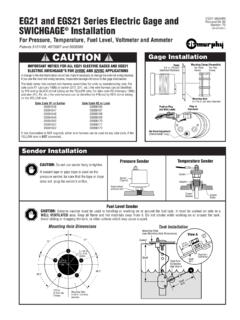Transcription of SERVO CONTROL FACTS - Baldor.com
1 SERVO CONTROL FACTSA HANDBOOK EXPLAININGTHE BASICS OF MOTIONBALDOR ELECTRIC COMPANYMN1205 TABLE OF CONTENTSTYPES OF MOTORS .. 3 OPEN LOOP/CLOSED LOOP .. 9 WHAT IS A SERVO .. 11 COMPENSATION .. 13 TYPES OF CONTROLS .. 15 TYPES OF FEEDBACK DEVICES . 17 TYPES OF ACTUATORS .. 22 Page 2 Page 3 SERVO CONTROL FactsTYPES OF MOTORSThe direct current (DC) motor is one of the first machines devised to convert electrical energy tomechanical power. Its origin can be traced to machines conceived and tested by Michael Faraday,the experimenter who formulated the fundamental concepts of electromagnetism. These conceptsbasically state that if a conductor, or wire, carrying current is placed in a magnetic field, a force willact upon it. The magnitude of thisforce is a function of strength of themagnetic field, the amount of currentpassing through the conductor andthe orientation of the magnet andconductor.
2 The direction in whichthis force will act is dependent on thedirection of current and direction ofthe magnetic motor design is based on theplacement of conductors (wires) in amagnetic field. A winding has manyconductors, or turns of wire, and thecontribution of each individual turnadds to the intensity of the interac-tion. The force developed from awinding is dependent on the currentpassing through the winding and the magnetic field strength. If more current is passed through thewinding, then more force (torque) is obtained. In effect, two magnetic fields interacting causemovement: the magnetic field from the rotor and the magnetic field from the stators attract eachother. This becomes the basis of both AC and DC motor MOTORSMost of the world's motor business is addressed by AC motors.
3 AC motors are relatively constantspeed devices. The speed of an AC motor is determined by the frequency of the voltage applied(and the number of magnetic poles). There are basically two types of AC motors: MOTOR. If the induction motor is viewed as a type of transformer, it becomesMAGNETIC FIELDCURRENTFORCEFig. 1 - CONCEPT OF ELECTROMAGNETISMROTOR FIELDSTATOR FIELDINDUCED VOLTAGEAND CURRENTFig. 2 - INDUCTION MOTORINDUCEDVIPage 4 SERVO CONTROL Factseasy to understand. By applying a voltage onto the primary of the transformer winding, a currentflow results and induces current in the secondary winding. The primary is the stator assembly andthe secondary is the rotor assembly. One magnetic field is set up in the stator and a second magnet-ic field is induced in the rotor.
4 The interaction of these two magnetic fields results in motion. Thespeed of the magnetic field going around the stator will determine the speed of the rotor. The rotorwill try to follow the stator's magnetic field, but will "slip" when a load is attached. Thereforeinduction motors always rotate slower than the stator's rotating construction of an induction motor consists of 1) a stator with laminations and turns of cop-per wire and 2) a rotor, constructed of steel laminations with large slots on the periphery, stackedtogether to form a "squirrel cage" rotor. Rotor slots are filled with conductive material (copper oraluminum) and are short-circuited upon themselves by the conductive end pieces. This "one" piececasting usually includes integral fan blades to circulate air for cooling standard induction motor is operated at a "constant" speed from standard line , with the increasing demand for adjustable speed products, controls have been developedwhich adjust operating speed of induction motors.
5 Microprocessor drive technology using meth-ods such as vector or phase angle CONTROL ( variable voltage, variable frequency) manipulates themagnitude of the magnetic flux of the fields and thus controls motor speed. By the addition of anappropriate feedback sensor, this becomes a viable consideration for some positioning the induction motor's speed/torque becomes complex since motor torque is no longer asimple function of motor current. Motor torque affects the slip frequency, and speed is a functionof both stator field frequency and slip motor advantages include: Low initial cost due to simplicity in motor design and con-struction; availability of many standard sizes; reliability; and quiet, vibration-free operation. Forvery rapid start-stop positioning applications, a larger motor would be used to keep temperaturesFig.
6 3 - CUTAWAY OF INDUCTION MOTORSTATOR LAMINATIONSSTATOR WINDINGSSQUIRREL CAGEROTORFANBLADESSHAFTHOUSINGPage 5 SERVO CONTROL Factswithin design limits. A low torque to inertia ratio limits this motor type to less demanding incre-menting (start-stop) applications. SYNCHRONOUS synchronous motor is basically the same as the inductionmotor but with slightly different rotor construction. The rotor construction enables this type ofmotor to rotate at the same speed (in synchronization) as the stator field. There are basically twotypes of synchronous motors: self excited( as the induction motor) anddirectly excited(as with per-manent magnets).The self excited motor (may be called reluctance synchronous) includes a rotor with notches, orteeth, on the periphery.
7 The number of notches corresponds to the number of poles in the the notches or teeth are termed salient poles. These salient poles create an easy path forthe magnetic flux field, thus allowing the rotor to "lock in" and run at the same speed as therotating field. A directly excited motor (may be called hysteresis synchronous, or AC permanent magnet synchro-nous) includes a rotor with a cylinder of a permanent magnet alloy. The permanent magnet northand south poles, in effect, are the salient teeth of this design, and therefore prevent both the self excited and directly excited types there is a "coupling" angle, the rotor lags asmall distance behind the stator field. This angle will increase with load, and if the load isincreased beyond the motor's capability, the rotor will pull out of synchronous motor is generally operated in an "open loop" configuration and within the limi-Fig.
8 4 - CUTAWAY OF AC SYNCHRONOUS MOTORSTATORSHAFTROTORSTATOR LAMINATIONSSTATOR WINDINGSROTORWITH TEETHOR NOTCHESHOUSINGSHAFTPage 6 SERVO CONTROL FactsSHUNT WOUND shunt wound, the rotor and stator (orfield windings) are connected in field windings can be connected tothe same power supply as the rotor, orexcited separately. Separate excitation isused to change motor speed ( rotorvoltage is varied while stator or fieldwinding is held constant).The parallel connection provides a rela-tive flat speed-torque curve and goodspeed regulation over wide load , because of demagnetizationeffects, these motors provide startingtorques comparatively lower than otherDC winding types. SERIES WOUND the series wound motor, the two motor fields are connected inseries.
9 The result is two strong fields which will produce very high starting torque. The fieldwinding carries the full rotor current. These motors are usually employed where large startingtorques are required such as cranes and hoists. Series motors should be avoided in applicationstations of the coupling angle (or "pull-out" torque) it will provide absolute constant speed for agiven load. Also, note that this category of motor is not self starting and employs start windings(split-phase, capacitor start), or controls which slowly ramp up frequency/voltage in order to synchronous motor can be used in a speed CONTROL system even though a feedback device mustbe added. Vector CONTROL approaches will work quite adequately with this motor design.
10 However,in general, the rotor is larger than that of an equivalent servomotor and, therefore, may not provideadequate response for incrementing applications. Other disadvantages are: While the synchronousmotor may start a high inertial load, it may not be able to accelerate the load enough to pull it intosynchronism. If this occurs, the synchronous motor operates at low frequency and at very irregularspeeds, resulting in audible noise. Also for a given horsepower, synchronous motors are larger andmore expensive than non-synchronous motors. DC MOTORSMost of the world's adjustable speed business is addressed by DC motors. DC motor speeds caneasily be varied, therefore they are utilized in applications where speed CONTROL , SERVO CONTROL ,and/or positioning needs exist. The stator field is produced by either a field winding, or by perma-nent magnets.

